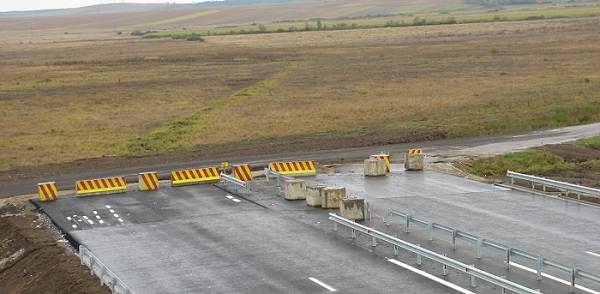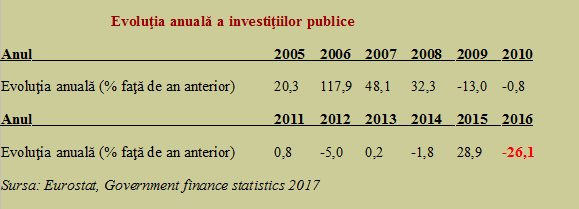 According to the Eurostat data, Romania is at the lowest level of public investment as a share of GDP in the entire period monitored, with only 3.6%.
According to the Eurostat data, Romania is at the lowest level of public investment as a share of GDP in the entire period monitored, with only 3.6%.
The figure is valid for 2016, but neither in 2017 did the institutions in charge exhausted the budget with investments.
The figure is much lower than in the previous year when it succeeded to recover above the five percent threshold. A critical threshold that it exceeded during the entire interval from 2006 to 2011 (see table)
*
- Year
- Investment as share of GDP
*
It can be noticed how the EU accession generated initially a relatively high interest for allocating public funds to investments. In the first two years after joining the EU and even in the first year of the economic crisis (indeed, also in the context of a sharp decline in GDP in 2009), the corresponding amounts exceeded 6%.
Unfortunately, over time, governments found it appropriate to cut investments, with the notable exception of 2015, the only year that got close to the good economic practices for financial stability and sustainable development of the country.
We remind that we had then a deficit of only -0.8% by the ESA standard and met the famous MTO – incidentally, it is less important whether the prime minister who held the office then knew what the English acronym for the medium-term objective means. The important thing is that we adjusted the structural deficit in a healthy way and we could have been the first in class.
However, instead of keep allocating public funds for the country’s development (to be read „motorways, schools and hospitals”, more simply explained), maybe also because the European money made available only for clear projects cannot be easily diverted anymore, we reversed the healthy trend and started to party with the money from the budget, while massively reducing the investments.
The figures provided by Eurostat also show in a nutshell and as clearly as possible that the sharpest decline in the allocations to public investment was also in 2016. Unfortunately, this practice continued in 2017 (including in the recent budget amendments, in the context of the difficulties in collecting the expected revenues and the hazardous commitments for wage and pension increases in the public sector)
… And 2017 …:
The figures on the budget implementation for the first ten months of 2017 show an increase (about seven billion lei above the disappointing results in 2016) in a year with amounts addressed to projects financed from non-reimbursable external funds, and a quite significant decrease in capital spending (about two billion lei below the same period of the previous year), but we should wait for the final result based on official European data.
*
- Annual evolution of public investment
- Year
- Annual evolution (% compared to the previous year)
*
… And 2018 …
To sustain public investments, in the draft budget for 2018, investment spending amounts to only RON 38.5 billion, which represents about 4.2% of GDP. That is, at least in statements and planned above the 2016 counter-performance, but still, the lowest percentage since 2006, even if this money is ultimately allocated.
Obviously, not enough compared to the needs that accumulated over time by failing to achieve major objectives such as the motorways to cross the Carpathians or regional hospitals where people would no longer die in large numbers because of the lack of medical equipment and in-hospital infections.
Without referring to numerous figures and creating a dispute about including the European funds as a public investment just to get a better result in terms of share of GDP, we raise just one question:
How much do WE, the taxpayers, allocate from our OWN money (so that we can access THEIRS) to public investment? Is it more or is it less than 5% of GDP (to have a simple benchmark, already quite obvious in the history of recent years)? That is, we care about the country, the society where we live, and maybe we would like our children to live, or we just want to spend as much money as possible for momentary consumption.











